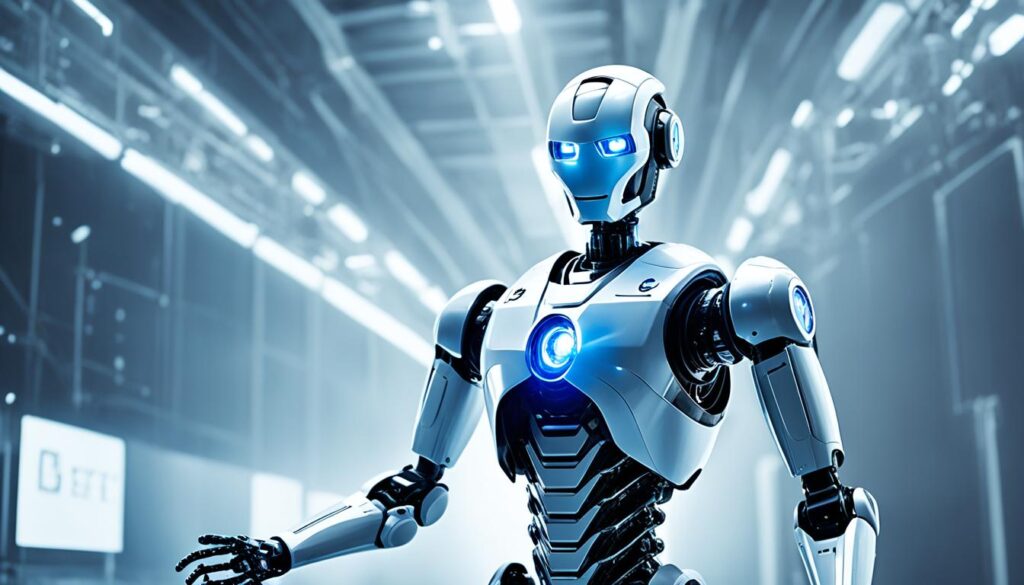The fusion of quantum computing and humanoid robotics is set to transform the future of artificial intelligence. Quantum computing’s capabilities, such as superposition and entanglement, could soon empower robots with unprecedented abilities. This could lead to the emergence of super-powered robots that surpass current technological limits.
These advanced machines will likely influence numerous fields, including industry, healthcare, and space exploration. As we examine this dynamic blend of technologies, we’ll see how quantum computing might transform humanoid robots into tomorrow’s super-powered entities. This could have significant effects on our world.
The Potential of Quantum Computing in Robotics
Quantum computing is set to transform robotics by speeding up complex task processing. It leverages quantum algorithms to solve problems classical computers can’t handle. This could greatly enhance robot decision-making, planning, and control.
Quantum computing’s impact on robotics machine learning is profound. Quantum algorithms can efficiently process vast sensory data, enabling robots to better understand and interact with their surroundings. For instance, they could train deep neural networks for tasks like object recognition and scene analysis.

Quantum computing also shows promise in tackling optimization problems. Robotics tasks, such as motion planning and task allocation, often involve optimization. Quantum algorithms, like the quantum approximate optimization algorithm (QAOA), outperform classical methods in solving these problems. This could lead to more efficient and effective robot operations in complex environments.
Researchers are actively exploring quantum computing and robotics through experiments and simulations. Some key examples include:
- Quantum algorithms for optimizing robotic arm control for grasping objects
- Quantum machine learning for improving robot localization and mapping accuracy
- Quantum sensors for enhancing robot perception and navigation
As quantum computing hardware improves and becomes more widely available, we’ll see more advancements in quantum robotics. The fusion of quantum computing with robotics could open up new capabilities and applications, expanding the potential of autonomous systems.
Enhancing Humanoid Robot Capabilities with Quantum Computing
The fusion of quantum computing with humanoid robots could revolutionize their performance. Quantum sensors, for instance, could grant these robots a heightened awareness. This would allow them to navigate complex environments and interact with objects in ways previously unimaginable.
Quantum sensors excel at detecting minuscule changes in their surroundings. This capability would enable humanoid robots to perceive subtle variations in temperature, pressure, and magnetic fields. Such an advanced perception would aid robots in navigating difficult terrain and avoiding unseen hazards.

Quantum computing also promises to elevate the robots’ ability to tackle complex tasks. Quantum control systems could ensure humanoid robots maintain stability and agility during precise movements. This is crucial in manufacturing, where robots must handle delicate components with utmost precision.
Moreover, quantum computing could boost the cognitive prowess of humanoid robots. It would allow them to process vast data sets and make decisions based on intricate algorithms. This could lead to robots that learn from their experiences and adapt to new situations more adeptly, potentially creating more intelligent and autonomous machines.
As quantum computing evolves, the potential for enhancing humanoid robot performance is vast. From superior sensory perception to advanced cognitive functions, quantum computing could redefine humanoid robotics. It may usher in a new era of super-powered machines.
Quantum Computing Powered Humanoid Robots
The field of quantum-powered humanoids is rapidly advancing, with leading institutions and companies at the forefront of research and development. IBM, Google, and MIT are pioneers in creating advanced robotics that harness quantum computing’s immense potential. These intelligent machines are set to revolutionize various industries and significantly impact our daily lives.
Manufacturing is a promising area for quantum-powered humanoids. These robots can optimize production processes, improve quality control, and streamline supply chain management with their enhanced computational capabilities. Their ability to process vast amounts of data and make real-time decisions will lead to increased efficiency and reduced costs in factory settings.
Healthcare is another domain where quantum-powered humanoids are expected to make a significant impact. These advanced robotics can assist in surgical procedures, providing precise and steady movements that surpass human capabilities. They can also analyze patient data, aiding in diagnosis and treatment planning. Furthermore, quantum-powered humanoids can serve as companions for elderly patients, offering personalized care and support.
Space exploration is yet another exciting frontier for quantum-powered humanoids. These intelligent machines can withstand the harsh conditions of space travel and perform complex tasks on distant planets. Their ability to process and analyze data in real-time will be invaluable for scientific research and future colonization efforts. Quantum computing will enable these robots to make autonomous decisions and adapt to unforeseen challenges in the vast expanse of space.
As quantum computing continues to advance, the capabilities of humanoid robots will expand exponentially. The synergy between these two cutting-edge technologies will unlock new possibilities and drive innovation across various sectors. From manufacturing and healthcare to space exploration and beyond, quantum-powered humanoids are set to transform the way we live and work, ushering in a new era of technological progress.
Societal Impact of Super-Powered Humanoid Robots
The emergence of quantum computing in humanoid robots is set to profoundly alter our society. These advanced machines will transform how we work and interact with technology. They promise to boost productivity and efficiency, leading to economic growth and better lives for many.
Yet, the advent of these super-powered robots stirs concerns over workforce automation and job displacement. As they tackle complex tasks, it’s vital to support reskilling and retraining. Governments, schools, and businesses must collaborate to ensure these benefits are shared fairly.
Addressing the ethical implications of these robots is paramount. As they gain autonomy and decision-making capabilities, we must set clear rules for their safe, transparent, and accountable use. Privacy, security, and misuse concerns must be tackled to keep public trust.
The way humans and robots interact will change as these robots become more advanced. With natural language processing and emotional intelligence, they could engage more empathetically with us. This could redefine how we collaborate and live with robots.
- Increased productivity and efficiency in various industries
- Workforce displacement and the need for reskilling programs
- Ethical considerations surrounding privacy, security, and accountability
- Evolution of human-robot interaction and collaboration
Debating the societal impact of super-powered humanoid robots is essential. By tackling challenges and opportunities proactively, we can ensure a future where these technologies benefit society. This approach prioritizes the well-being and interests of all stakeholders.
The Future of Quantum Computing and Humanoid Robotics
The intersection of quantum computing and humanoid robotics is set to revolutionize technology. Early stages of research are moving swiftly, hinting at significant advancements in the near future. Quantum computing’s prowess in tackling complex problems could empower humanoid robots with unmatched intelligence, autonomy, and flexibility.
Quantum-powered humanoid robots could revolutionize various sectors. They could handle tasks deemed too perilous, complex, or time-consuming for humans. As quantum computing advances, these robots will likely boast superior sensory perception, decision-making, and physical agility. This will enable them to navigate intricate environments and interact with humans more seamlessly.
Yet, the advent of these technologies also stirs concerns about their societal implications. They may displace human jobs in certain fields, yet could also spawn new industries needing specialized skills in quantum computing, robotics, and AI. Navigating the dual impact of this technological shift will be crucial for researchers, policymakers, and society.
Despite the hurdles, the future of quantum computing and humanoid robotics is thrilling. Ongoing research is continually expanding what we can achieve. We envision a future where intelligent, adaptable, and powerful humanoid robots collaborate with humans, augmenting our abilities and redefining how we live and work. The fusion of these technologies could open up new avenues in science, medicine, and exploration, setting the stage for a future full of possibilities.
